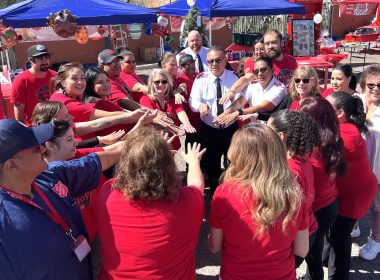We will appreciate the value of remembering by first examining the danger of forgetting. Even a quick read of the Old Testament reveals a shocking memory loss for the Israelites. The following admonitions are framed in the context of warning and lament for having already forgotten:
- Be careful that you do not forget the Lord (Deut. 6:12).
- Praise the Lord, O my soul, and forget not all his benefits (Ps. 103:2).
- Do not forget my words or turn away from them (Prov. 4:5).
- [Who are you] that you should forget the Lord your Maker? (Is. 51:13)
The consequences for forgetting God and his precepts are among the saddest passages in the Bible.
As the Israelites traversed their land, they built altars of remembrance. The naming of the altars recalled an event in which God revealed himself in a special way. As families traveled, they would pass these altars, pause and remember (rehearse). Those altar moments renewed memories of lessons learned and the call to be faithful to God (e.g., Gen. 8:20; 12:7-8, 26:23-25; Ex. 17:14-16; Josh. 22:34).
Just as there were legitimate altars to remember the one true God and his acts, there were false altars erected by the heathen neighbors who worshiped idols—idols Israel was all too prone to adopt in spite of God’s strict prohibition.
Moses’ words summarize what we are to remember:
And now, O Israel, what does the Lord your God ask of you but to fear the Lord your God, to walk in obedience to him, to love him, to serve the Lord your God with all your heart and with all your soul, and to observe the Lord’s commands and decrees that I am giving you today for your own good? (Deut. 10:12-13)
Why the considerable emphasis on remembering in the Scripture? The obvious reason is that sin is forever present in this world and the temptation to wander from our Creator is always near and real. But the Creator may have had another reason for us to remember: the brain tends to function more efficiently and consistently when neural networks are stronger. For example, when one has a strong God-consciousness—that is, reflects on God at various times during the day—that neural pathway becomes more dominant in our thoughts and actions. That pathway has “tentacles” (dendrites) that allow a wide range of experiences to connect to the God-consciousness. The more we connect life experiences to God, the good and the bad, the stronger our “altar” of worship and the more likely we will resist erecting false altars.
For example, while driving down the road, you see an accident. You might realize that God has protected you and your loved ones and give thanks. But you might also realize that God is present with those in the accident and pray for their well-being, recovery, and—in the midst of all that entails—acknowledge him. Perhaps you might stop and be God’s presence by helping.
But suppose you are the one in the accident. One tendency is to curse your “rotten luck,” seethe in anger at the other driver, or curse the hassle of getting through this mess. A God consciousness interrupts those thoughts with: God is here. He is present. What does he want to accomplish in this situation that I would have preferred to avoid? How then should I think and behave so that his presence will be apparent to the others who would also have preferred to avoid this misfortune?
The strength of the God-conscious neural pathway, from frequent daily use, creates a habit response that keeps God as the reference point for how we see and respond to life circumstances. It goes without saying, no one is perfect. But it is also true that the formation of good habits will help us turn difficult times into “altars” of worship to our God. Those difficult life events can be cues that activate a thought habit, a God-consciousness habit. We need to ask, What do we want people (including ourselves) to remember about God after we walk away from a situation . . . especially the less than happy ones?
The altars reminded Israel of their covenant God, and these reminders became connecting points for other life situations. In the same way, our learners, to make any sense out of content, need connection points to pre-existing content or experiences already imprinted in the brain—the “meaning” function. The brain waits to be stimulated with new material that connects with other content from past learning already stored there. This has been self-evident for decades among educators. Yet it seems not to have much traction in our classrooms as we jump into our lecture for the day assuming that the minds will immediately see the relevance to their lives. It is simply fallacious to assume learners will automatically “connect” to our lecture notes (or our sermons, for that matter).
The rush to get through is based on the questionable assumptions that:
- The learners will return to their notes at some future date and “get it.”
- They will understand what they have written later.
- The notes will prompt them to some relevant action later.
- The learners cannot get the content anywhere else.
Think about these assumptions. How many are true of you? Did you review your class or sermon notes years later? And did they make sense? Did old notes prompt you to some behavior change? Or, when the need arose to review the same content, did you rather Google the material, read an article, or take a book on the topic out of the library rather than rely on your notes from class?
Doing less, better, is really a superior way. Failure to connect content with the learners’ experiences, from the standpoint of transformation, is virtually a waste of time—or so the brain researchers suggest. Sousa says only what enters working memory may have a chance to enter long-term memory and affect core assumptions. For the Christian, this relates to character formation and spiritual development.
Here’s the point: teaching to pass tests, hurdle a barrier, hold up a piece of paper with embossed name and achievement, elevate oneself in a company, or build the retirement account miss the point. All of these are good, but they are not the goal of teaching and should not be the goal of learning. We teach and learn for wholeness; the undivided life; building the seamless tapestry of our character where our words and our actions merge as one, mutually reinforcing each other toward integrity—the journey to Christlikeness.
Here is my attempt to engage with my students’ reality. In my undergrad cross-cultural ministry classes, I knew many of the students were there because the time frame fit their schedule or they were meeting a core requirement. Yes, some came quite motivated but still unsure if this class would be “worth it.” My first words were: This could be the best class you will ever take in preparation for…marriage,” and when the amusement settled, I added, “because marriage is the biggest cross-cultural experience you will ever have.” At that point, I had touched the hot topic that had been zip-lining through the brains of these juniors and seniors since entering college if not well before. A palpable curiosity suddenly consumed the room. They learned that the skills for living in a new culture were parallel to those necessary for living with another person—even if they grew up across the street from each other.
When we teach, we are not simply teaching content, we are teaching people. People learn in certain ways that reflect the design of their Creator and that must be respected if our goal of maturity in Christ is to be realized. Teaching in a way that makes content memorable takes thought and effort.
Taken from The Learning Cycle by Muriel I. Elmer and Duane H. Elmer. Copyright © 2020 by Muriel I. Elmer and Duane H. Elmer. Published by InterVarsity Press, Downers Grove, IL. www.ivpress.com.
Do Good:
- Read more in The Learning Cycle: Insights for Faithful Teaching from Neuroscience and the Social Sciences by Muriel I. Elmer and Duane H. Elmer (InterVarsity Press, 2020).
- See how you can get involved in the Fight for Good at westernusa.salvationarmy.org.
- Did you know The Salvation Army served more than 23 million Americans last year fighting hunger, homelessness, substance abuse and more—all in a fight for good? Where can you help? Take our quiz to find your cause and learn how you can join in today.













